Teeth Whitening: Gentle Bleach For Healthier Gums
The pursuit of a brighter, more radiant smile has become a significant aspect of oral care and aesthetic appeal. Among the various methods available for achieving this goal, teeth whitening stands out as a popular and effective procedure. However, the concern for the health of the gums often arises, especially when considering the use of bleach, a common teeth whitening agent. The balance between achieving a whiter smile and maintaining healthier gums is a delicate one, necessitating an understanding of the gentle bleach options available and their implications on gum health.
Understanding Teeth Whitening
Teeth whitening is a cosmetic dental procedure designed to remove stains and discoloration from teeth, resulting in a whiter and brighter appearance. This can be achieved through various methods, including at-home kits, professional in-office treatments, and customized trays provided by dentists. The primary active ingredient in most teeth whitening products is hydrogen peroxide or carbamide peroxide, which acts as a bleach to penetrate the tooth enamel and break down stains.
The Role of Bleach in Teeth Whitening
Bleach, in the form of hydrogen peroxide, is the key component of teeth whitening treatments. It works by oxidizing the chromogens (colored molecules) that cause tooth discoloration, thereby lifting stains and whitening the teeth. However, the concentration of hydrogen peroxide can vary significantly among different products, ranging from mild over-the-counter solutions to stronger, professionally applied gels.
Concerns for Gum Health
One of the primary concerns with teeth whitening, particularly when using bleach, is the potential impact on gum health. Strong bleach concentrations can irritate the gums, leading to sensitivity, redness, and discomfort. Furthermore, improper application or prolonged exposure to bleach can exacerbate pre-existing gum conditions, such as gingivitis.
Gentle Bleach Options for Healthier Gums
Fortunately, advancements in teeth whitening technology have led to the development of gentle bleach options that prioritize both the whitening of teeth and the health of the gums. These innovations include:
- Low-Concentration Bleach: Some at-home whitening kits and professional treatments now offer lower concentrations of hydrogen peroxide, reducing the risk of gum irritation while still providing effective whitening.
- Desensitizing Ingredients: Many modern whitening products incorporate desensitizing ingredients to minimize tooth sensitivity, a common side effect of bleach application. These ingredients can also help in soothing the gums.
- Gum Protection Barriers: Professional teeth whitening treatments often include the application of a protective barrier along the gum line to prevent the bleach from coming into contact with the gums.
- Customized Whitening Trays: Dentists can provide customized whitening trays that fit snugly over the teeth, minimizing the exposure of the gums to the whitening gel.
Best Practices for Safe Teeth Whitening
To ensure that teeth whitening is both effective and gentle on the gums, several best practices should be followed:
- Consult a Dentist: Before starting any teeth whitening treatment, it’s advisable to consult with a dentist. They can assess the health of your teeth and gums, recommend the most suitable whitening method, and provide guidance on how to minimize potential side effects.
- Follow Instructions: Adhere strictly to the instructions provided with your whitening product, whether it’s an at-home kit or a professional treatment.
- Monitor Gum Health: Keep a close eye on the condition of your gums during and after the whitening process. If you experience any discomfort, sensitivity, or signs of irritation, discontinue the treatment and consult your dentist.
- Maintain Good Oral Hygiene: Regular brushing, flossing, and dental check-ups are crucial for maintaining the health of your gums and ensuring the longevity of your whitened smile.
Conclusion
Achieving a whiter smile while preserving the health of your gums is a realistic goal with the right approach to teeth whitening. By understanding the role of bleach in the whitening process, being aware of the potential risks to gum health, and opting for gentle bleach options and best practices, individuals can enjoy the benefits of teeth whitening without compromising their oral well-being. As with any dental treatment, professional guidance is invaluable, ensuring that the pursuit of aesthetic appeal does not come at the cost of health.
FAQ Section
What are the common side effects of teeth whitening on gums?
+Common side effects include gum irritation, sensitivity, and in some cases, inflammation. These effects are usually temporary and can be minimized with the right precautions and gentle bleach concentrations.
How can I protect my gums during teeth whitening?
+Protecting your gums involves using a gum protection barrier during professional treatments, following the instructions carefully, and possibly using desensitizing toothpaste. Customized whitening trays can also help in minimizing gum exposure to the bleach.
Are at-home teeth whitening kits safe for my gums?
+At-home kits can be safe if used correctly and with caution. It's essential to choose a reputable brand, follow the instructions precisely, and start with a lower concentration of bleach to gauge your sensitivity and gum reaction.
In the realm of oral aesthetics and health, the harmonious balance between achieving a whiter smile and maintaining healthier gums is not only achievable but also essential. With the ongoing advancements in dental technology and the availability of gentle bleach options, individuals can now pursue their desired smile with confidence, knowing that their gum health is prioritized.

